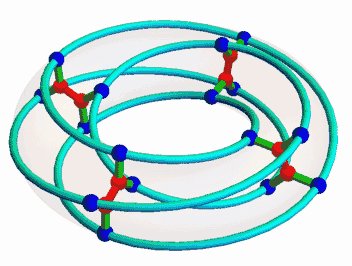March 26, 2025
The McGee Group
Posted by John Baez
This is a bit of a shaggy dog story, but I think it’s fun. There’s also a moral about the nature of mathematical research.
Once I was interested in the McGee graph, nicely animated here by Mamouka Jibladze:

This is the unique (3,7)-cage, meaning a graph such that each vertex has 3 neighbors and the shortest cycle has length 7. Since it has a very symmetrical appearance, I hoped it would be connected to some interesting algebraic structures. But which?
March 20, 2025
Visual Insights (Part 2)
Posted by John Baez
From August 2013 to January 2017 I ran a blog called Visual Insight, which was a place to share striking images that help explain topics in mathematics. Here’s the video of a talk I gave last week about some of those images:
It was fun showing people the great images created by Refurio Anachro, Greg Egan, Roice Nelson, Gerard Westendorp and many other folks. For more info on the images I talked about, read on….
March 12, 2025
Category Theory 2025
Posted by Tom Leinster
Guest post by John Bourke.
The next International Category Theory Conference CT2025 will take place at Masaryk University (Brno, Czech Republic) from Sunday, July 13 and will end on Saturday, July 19, 2025.
Brno is a beautiful city surrounded by nature with a long tradition in category theory. If you are interested in attending, please read on!
Important dates
- April 2: talk submission
- April 18: early registration deadline
- May 7: notification of speakers
- May 23: registration deadline
- July 13-19: conference
In addition to 25 minute contributed talks, there will be speed talks replacing poster sessions, and we hope to accommodate as many talks as possible.
The invited speakers are:
- Clark Barwick (University of Edinburgh)
- Maria Manuel Clementino (University of Coimbra)
- Simon Henry (University of Ottawa)
- Jean-Simon Lemay (Macquarie University)
- Wendy Lowen (University of Antwerp)
- Maru Sarazola (University of Minnesota)
March 7, 2025
Visual Insights (Part 1)
Posted by John Baez
I’m giving a talk next Friday, March 14th, at 9 am Pacific Daylight time here in California. You’re all invited!
(Note that Daylight Savings Time starts March 9th, so do your calculations carefully if you do them before then.)
Title: Visual Insights
Abstract: For several years I ran a blog called Visual Insight, which was a place to share striking images that help explain topics in mathematics. In this talk I’d like to show you some of those images and explain some of the mathematics they illustrate.
Zoom link: https://virginia.zoom.us/j/97786599157?pwd=jr0dvbolVZ6zrHZhjOSeE2aFvbl6Ix.1
Recording: This talk will be recorded, and eventually a video will appear here: https://www.youtube.com/@IllustratingMathSeminar
March 4, 2025
How Good are Permutation Represesentations?
Posted by John Baez
Any action of a finite group on a finite set gives a linear representation of on the vector space with basis . This is called a ‘permutation representation’. And this raises a natural question: how many representations of finite groups are permutation representations?
Most representations are not permutation representations, since every permutation representation has a vector fixed by all elements of , namely the vector that’s the sum of all elements of . In other words, every permutation representation has a 1-dimensional trivial rep sitting inside it.
But what if we could ‘subtract off’ this trivial representation?
There are different levels of subtlety with which we can do this. For example, we can decategorify, and let:
the Burnside ring of be the ring of formal differences of isomorphism classes of actions of on finite sets;
the representation ring of be the ring of formal differences of isomorphism classes of finite-dimensional representations of .
In either of these rings, we can subtract.
There’s an obvious map , since any action of on a finite set gives a permutation representation of on the vector space with basis .
So I asked on MathOverflow: is typically surjective, or typically not surjective?
 Posts with this logo use
Posts with this logo use 














